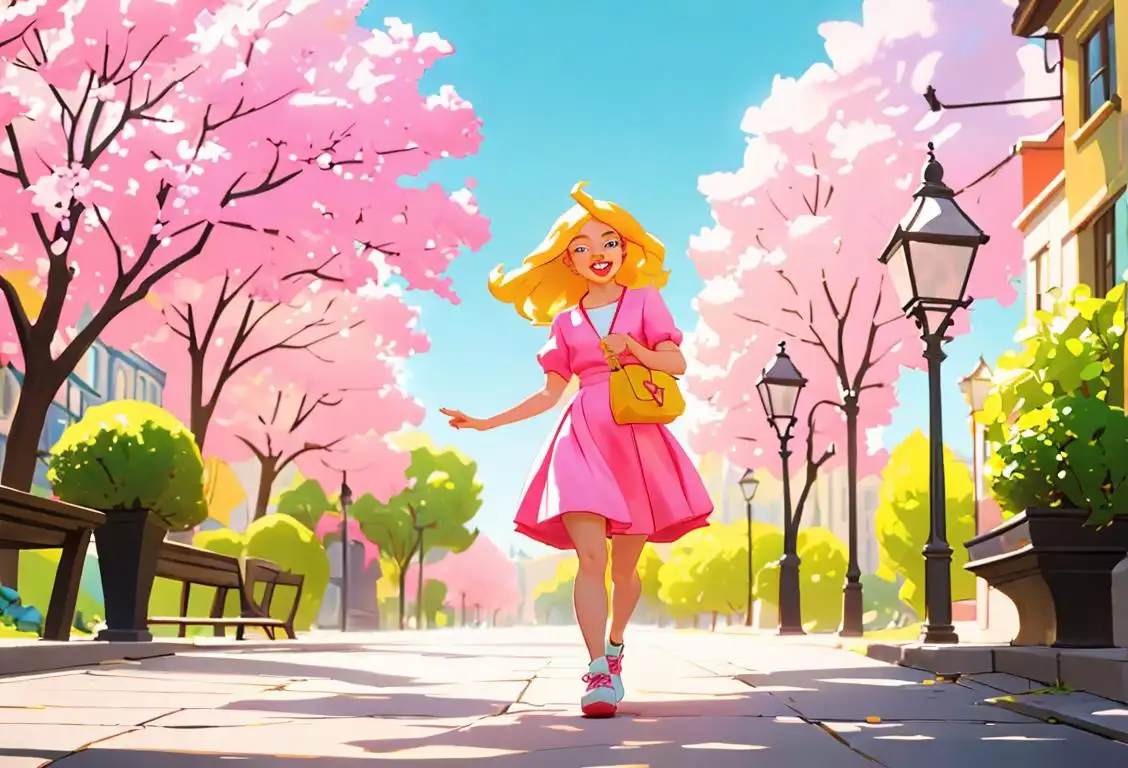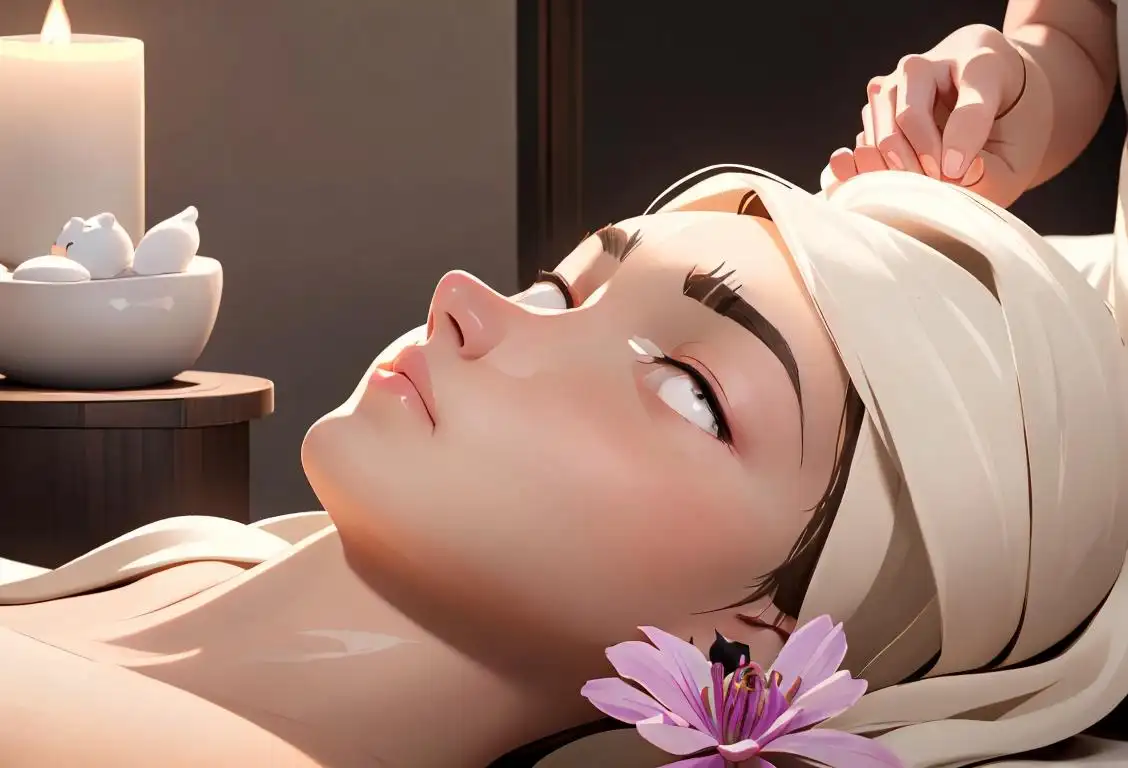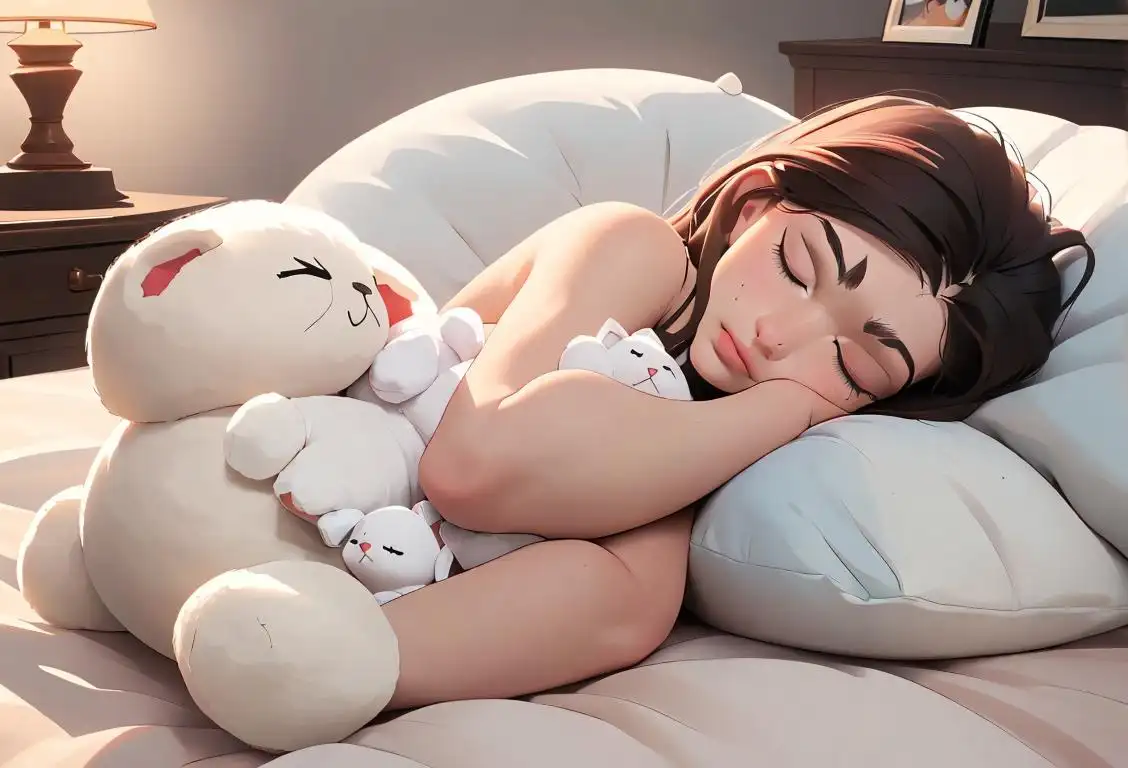National Chill Out Day

Welcome to National Chill Out Day, the day dedicated to enjoying some well-deserved relaxation! Grab your comfiest pajamas, fluff up those pillows, and get ready to kick back and unwind. Whether you prefer binge-watching your favorite TV show, indulging in your go-to comfort food, or simply taking a long nap, today is the perfect excuse to just chill out and recharge your batteries.
When is Chill Out Day?
It's national chill out day on the 5th April.
The Origins of National Chill Out Day
As with many national days, the exact origins of National Chill Out Day are a bit hazy. However, we can all agree that the concept of taking a break and relaxing is universally cherished. The internet has played a significant role in spreading awareness and enthusiasm for this soothing holiday, with numerous mentions and online discussions happening every year.
One notable spike in mentions occurred on April 5, 2018, when people found solace in sharing their favorite chill-out activities and encouraging others to embrace the art of relaxation.
History behind the term 'Chill Out'
1625
Emergence of 'chill' as a verb
In the year 1625, the term 'chill' first emerged as a verb in the English language. It was used to describe the act of cooling or becoming cold, often in reference to weather or temperature. The word itself is believed to have originated from the Old English word 'cield', meaning cold or cool.
1950
Origin of 'Chill Out'
The term 'chill out' originated in the 1950s as a slang expression in African American communities. Its original meaning referred to the act of remaining calm and relaxed, especially in tense situations. It was often used as a way to tell someone to calm down and take it easy.
1970
Deep Roots in Jazz
The term 'chill out' has its origins in the world of jazz music. In the 1970s, jazz musicians often used the phrase 'chill out' to encourage each other to relax and take it easy. It became a common expression among jazz performers to set a laid-back mood and to encourage improvisation during their performances. The phrase quickly spread within the jazz community, becoming synonymous with creating a relaxed and cool atmosphere.
1969
The Birth of 'Chill Out'
The term 'chill out' was first used in the late 1960s and early 1970s. It originated from the slang term 'cool out,' which was commonly used in African American communities. 'Cool out' meant to relax, calm down, or take it easy. It became popularized in urban areas and gradually evolved into the more widely used 'chill out' in the following years.
1980s
Frosted Flakes and Chill
In the 1980s, a new phrase emerged in American slang: 'chill out.' This term was initially popularized by a well-known cereal mascot. Tony the Tiger, the animated mascot for Frosted Flakes cereal, introduced the catchphrase 'Frosted Flakes and chill out' in TV commercials. The phrase, intended to mean relaxing with a bowl of cereal, quickly caught on among children and teens, spreading the idea of 'chilling out' as a way to relax and unwind.
1950
The Birth of Cool
In the 1950s, a new jazz movement emerged called 'cool jazz,' which was characterized by a more relaxed and laid-back style compared to the energetic bebop. This music genre, led by musicians like Miles Davis and Dave Brubeck, aimed to create a calm and mellow atmosphere for listeners.
1970
Origin of 'chill out' as a verb phrase
The term 'chill out' originated in the 1970s as a verb phrase used in African American communities. It was first used in underground clubs and parties to describe the act of relaxing, being cool, and enjoying oneself. The phrase quickly gained popularity within these circles and became associated with a laid-back attitude and a sense of tranquility.
1933
Emergence of the term 'chill out'
The term 'chill out' first emerged in the early 1930s jazz scene. It was used to describe the practice of musicians taking a break or relaxing between their performances. The phrase 'chill out' captured the idea of taking time to cool off and unwind after an energetic performance, reflecting the laid-back attitude of jazz musicians.
1970
Birth of 'chill out'
The term 'chill out' was first coined in the 1970s in African American communities, primarily within jazz and funk music scenes. It referred to the act of relaxing or calming down, often used as advice to someone who was feeling stressed or agitated. The phrase quickly gained popularity and became part of the cultural lexicon.
1980
Expansion into mainstream culture
In the 1980s, 'chill out' started to make its way into the mainstream culture. It was adopted by the youth in particular, who embraced the idea of chilling out as a way to escape stress and pressure. The term became a part of the vernacular, often used to advise others to calm down or relax in various situations.
1979
Introduction of 'chill out' as a slang phrase
Fast forward to 1979, and 'chill out' started being used as a slang phrase. It referred to the act of relaxing or calming down, particularly in response to stress or tension. The phrase gained popularity among counterculture movements and was commonly used in casual conversations, especially within youth communities.
1987
Musical Influence
In 1987, the term 'chill out' gained further prominence through the rise of a music genre known as 'chillout' or 'downtempo.' This genre featured mellow, atmospheric electronic music intended to create a relaxed and soothing ambiance. The phrase 'chill out' became closely associated with this genre, reflecting its calming, laid-back nature.
1990s
The Birth of Chillout Music
The term 'chill out' gained further prominence in the 1990s with the rise of a new genre of electronic music called 'chillout' or 'chill.' This music style, characterized by its calming and laid-back vibes, provided the perfect soundtrack for relaxation. Artists like The Orb, Kruder & Dorfmeister, and Boards of Canada helped popularize the chillout genre and its associated terminology, including 'chill out' as a verb phrase meaning to relax or calm down.
1980
Expansion of 'Chill Out'
In the 1980s, the term 'chill out' began to gain popularity beyond its original community. It started to be used more widely in popular culture, particularly in music and movies. This helped spread the phrase to a larger audience, with its meaning evolving to include the idea of relaxing and enjoying oneself.
1980
Reggae Influence
During the 1980s, the term 'chill out' started to gain popularity beyond the jazz scene. It made its way into the reggae music culture, where it was used to describe a relaxed and mellow style of reggae music. Reggae artists like Bob Marley and Peter Tosh popularized the phrase and helped to bring it into the mainstream. 'Chill out' became associated with mellow vibes, positive energy, and a laid-back attitude.
1970
Expansion of 'chill out' into popular culture
In the 1970s, 'chill out' made its way into popular culture, particularly among the countercultural movements of the time. The term started to be used outside of the jazz realm to describe a state of relaxation and calmness. It became associated with letting go of stress and embracing a more easygoing attitude in various areas of life, including music, lifestyle, and attitude.
1970
Chilling with Reggae
During the 1970s, reggae music gained popularity worldwide. One of its iconic figures, Bob Marley, introduced a term that perfectly complemented the tranquil vibes of the music - 'chill out.' The phrase 'chill out' in the context of reggae referred to relaxing and enjoying the soothing rhythms of the genre.
1980
Expansion into popular culture
Throughout the 1980s, 'chill out' started to penetrate broader popular culture. The term made its way into movies, television shows, and even song lyrics, solidifying its position as a mainstream phrase. It became a shorthand way to tell someone to calm down, take it easy, or just relax.
1980
Chilling in the British Club Scene
In the 1980s, the term 'chill out' began to be associated with the British club scene. DJs in clubs started to use 'chill out' as a descriptor for a separate area where people could relax and listen to slower-paced music after dancing to more energetic tunes. 'Chill out rooms' became popular as spaces for clubgoers to unwind and recharge.
2000s
From Music to Everyday Language
The term 'chill out' transcended its association with music and became a part of everyday language during the 2000s. It started being used more broadly to advise someone to relax, destress, and take it easy. Whether it was telling a friend to 'chill out' during a heated argument or suggesting to 'chill out' after a long day at work, the phrase became a popular way to encourage relaxation and calmness in various situations.
1990
Rise of Chill-out Rooms
In the 1990s, the term 'chill out' found a home in the emerging rave and electronic music scene. In these settings, 'chill out' referred to dedicated spaces where partygoers could relax, unwind, and escape the high-energy atmosphere of the dance floor. These chill-out rooms were often dimly lit, filled with comfortable seating, and played ambient or downtempo music. The concept of 'chilling out' in these spaces became an integral part of the rave culture and contributed to the popularity of the term.
1990s
Mainstream Popularity
During the 1990s, the term 'chill out' exploded into mainstream popularity. It was frequently used in casual conversations, music lyrics, and media. The phrase came to represent a state of relaxation, a call to let go of stress and worries, and to adopt a more calm and composed attitude. 'Chill out' became part of the everyday vernacular, symbolizing a desire for tranquility in an increasingly fast-paced world.
1990
Rise of 'chill out' music genre
In the 1990s, the term 'chill out' took on a new meaning with the emergence of a music genre known as 'chill out' or 'chillout music.' This genre was characterized by its mellow and soothing sound, often incorporating elements of ambient, downtempo, and trip-hop. The music aimed to create a relaxed atmosphere, providing listeners a chance to unwind and escape the stress of everyday life.
1990
Rise of chill-out music
In the 1990s, 'chill out' took a new dimension with the emergence of chill-out music. This genre, also known as ambient or downtempo, provided a calm and soothing sonic experience, perfectly complementing the concept of chilling out. Artists like The Orb and Kruder & Dorfmeister popularized this genre, which became synonymous with relaxation and unwinding.
1990
Growing cultural influence of 'chill out'
By the 1990s, 'chill out' became a cultural phenomenon, closely associated with the emergence of electronic music genres like ambient, downtempo, and trip-hop. The term was used to describe the soothing and laid-back nature of these musical styles, which aimed to create a tranquil and mellow atmosphere. 'Chill-out rooms' were also established in raves and clubs, providing spaces where people could relax and unwind.
1990
Mainstream Adoption
By the 1990s, 'chill out' had fully entered mainstream language and became widely recognized and used by people of all backgrounds. It became a trendy expression to describe the state of unwinding and taking a break from daily stresses. This decade also saw the emergence of the 'chill out' genre of music, characterized by soothing and atmospheric tunes aimed at promoting relaxation.
1980
Introduction of 'chill out' in music genres
During the 1980s, electronic music genres like ambient, downtempo, and chillwave started to emerge, embracing the concept of 'chill out' as a distinct genre. These genres incorporated slow and atmospheric soundscapes, fostering a sense of relaxation and introspection. 'Chill out' became a widely used term to describe this particular style of music, which aimed to create a soothing and calming listening experience.
Present Day
A Globalized Phrase
In the present day, 'chill out' has become a widely recognized and used phrase across the globe. It has transcended its origins in cereal commercials and music genres to become a part of everyday vernacular in numerous languages. 'Chill out' is now synonymous with taking a break, unwinding, and finding inner peace amidst the busyness of modern life. So next time you feel the need to relax, remember to 'chill out' like Tony the Tiger, and enjoy a moment of calm.
1990
Mainstream Adoption
In the 1990s, 'chill out' transitioned from being a niche term within specific music scenes to a more mainstream phenomenon. The rise of ambient and electronic music genres, along with the increasing popularity of relaxation and meditation techniques, brought 'chill out' into popular culture. It began to be used as an expression to encourage relaxation and stress reduction.
1990
Mainstream adoption of 'chill out'
In the 1990s, 'chill out' entered the mainstream consciousness. It became a descriptor for a wide range of activities and settings that promoted relaxation and tranquility. From lounge areas in clubs to spa treatments, 'chill out' became associated with creating spaces and experiences conducive to unwinding and finding inner peace away from the fast-paced nature of modern life.
2000
Mainstream Popularity
By the 2000s, 'chill out' had firmly embedded itself in popular culture. The phrase became widely used to encourage relaxation, stress relief, and taking a break from the hectic pace of everyday life. It appeared in various forms of media, including music, movies, and advertising. 'Chill out' playlists became popular on streaming platforms, offering listeners a curated selection of calming and soothing songs to unwind. The term continued to expand its reach and is now recognized globally as a way to encourage relaxation and calmness in our fast-paced world.
2000s
Global Influence
With the widespread adoption of the internet and social media platforms, the term 'chill out' transcended borders and reached a global audience. Memes, online forums, and viral videos all contributed to its further popularity, ensuring its place in contemporary culture. 'Chill out' became a catchphrase, urging individuals to find balance, relax, and take time for self-care amidst the chaos of modern life.
2000
Global recognition and commercialization
By the 2000s, 'chill out' had achieved global recognition and had undergone significant commercialization. The term became part of advertising campaigns, product branding, and even the names of establishments such as 'chill-out lounges' and 'chill-out zones.' Its universal appeal and association with leisure and tranquility made it a desirable term for businesses and marketers.
2000
Digital Age Influence
With the rise of the internet and social media in the early 2000s, 'chill out' found a new platform for its usage. Memes, online communities, and digital communication channels helped further spread the term's popularity, making it even more ingrained in modern vernacular.
2000s
Mainstream adoption and broader meaning
In the early 2000s, 'chill out' transitioned from being a niche slang phrase to a mainstream expression. It expanded in meaning to encompass a wide range of contexts beyond just relaxation, representing a general desire to take it easy, go with the flow, or not get overly worked up about things. 'Chill out' became a ubiquitous phrase in popular culture, appearing in music lyrics, movies, and everyday conversations.
2000
Global popularity and internet culture
With the advent of the internet and social media in the early 2000s, the term 'chill out' gained even more traction. It became a popular hashtag on platforms like Twitter and Instagram, with people using it to caption photos or describe their state of mind. 'Chill out' also became associated with memes and online content that promoted taking things easy and finding balance in a fast-paced world.
Present
Continued usage and evolution
Today, 'chill out' remains a popular and versatile phrase used worldwide. It has evolved to represent a state of mind characterized by being relaxed, easygoing, and unperturbed. Whether it's telling someone to 'chill out' or using it to describe a pleasant atmosphere, the term has firmly embedded itself in modern language and continues to shape our cultural understanding of leisure and calmness.
Present
Integration into everyday language
Today, 'chill out' has seamlessly integrated into everyday language, used across different cultures and age groups. It continues to be a popular phrase employed to encourage relaxation, relieve stress, and promote a laid-back attitude. Whether used as advice, in music, or as a cultural reference, 'chill out' remains an enduring term that encourages individuals to embrace a calm and tranquil state of mind.
2000
'Chill out' goes digital
With the advent of the internet and the rise of social media platforms, 'chill out' took on a new dimension. Online communities and forums embraced the term, creating virtual spaces for people to share calming content, relaxation techniques, and mindfulness practices. 'Chill out' playlists and relaxation videos gained popularity on platforms like YouTube and Spotify, allowing people to access soothing music and visual content with ease.
2000
Chill Out in Digital Conversations
With the proliferation of the internet and digital communication, the term 'chill out' found its way into online conversations. It became a commonly used phrase to advise others to calm down, relax, or take it easy during heated discussions or stressful situations. 'Chill out' became an internet slang term widely used in forums, chat rooms, and social media platforms.
Present
Continued Relevance
Today, 'chill out' remains a widely recognized and commonly used expression across various contexts. It is often used to advise others to relax, destress, or take a step back from a hectic situation. Whether used casually among friends or in professional settings, 'chill out' continues to signify the importance of finding inner peace and maintaining a calm demeanor.
Present
Continued usage and cultural significance
Today, 'chill out' remains a widely used term in various contexts. It is employed in everyday conversations, music playlists, wellness practices, and relaxation techniques. The phrase embodies the desire to find peace, tranquility, and a moment of calm amidst the chaos of modern life. Whether it's telling someone to relax or seeking a moment of solace for oneself, 'chill out' has become an integral part of our cultural vocabulary.
Did you know?
Did you know that taking regular breaks and allowing yourself to chill out has been linked to increased productivity and overall well-being? So, don't feel guilty about taking a day to do nothing - it's actually good for you!Tagged
awareness fun relaxationFirst identified
18th April 2016Most mentioned on
5th April 2018Total mentions
22Other days
Nothing Day
Jkap Day
Bubble Bath Day
Drop Everything And Read Day
Lazy Lazy Day
Walk Around Things Day
No Children Day
Massage Day
Ignore Day
Nap Day








